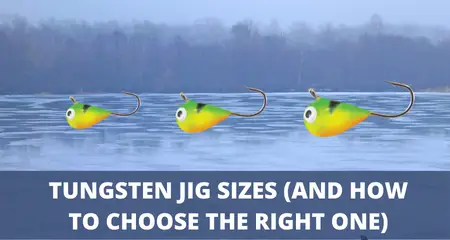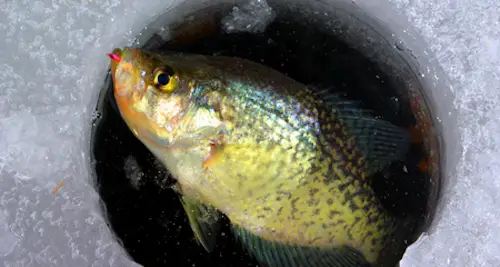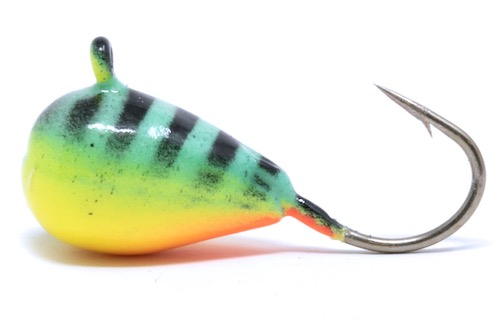Tungsten Jig Size Chart (And How To Choose The Right Size)
UPDATED 18 MAY 2023
by Robert Ceran
Tungsten jigs have become some of the most popular ice fishing lures for bluegill, crappie, and other panfish.
More and more ice anglers are becoming aware of the exceptional benefits that tungsten provides for hard water fishing.
However, choosing the right size tungsten jig can be challenging, since they are significantly denser than traditional lead jigs, and are thus used for smaller bait profiles.

In this article we’ll walk you through the different tungsten jig sizes, and how to choose the right one for your purposes.
Tungsten jig size chart
| Jig size (mm) | Jig weight (oz) | Hook size | Recommended water depth |
|---|---|---|---|
| 2 mm | 1/128 oz | #14 | 1 to 5 feet |
| 3 mm | 1/64 oz | #12 | 5 to 10 feet |
| 4 mm | 1/32 oz | #10 | 10 to 15 feet |
| 5 mm | 1/16 oz | #8 | 15 to 20 feet |
| 6 mm | 3/16 oz | #6 | 25 to 30 feet |
| 7 mm | 1/8 oz | #4 | 30 to 35 feet |
| 8 mm | 1/4 oz | #3 | 35 to 40 feet |
The table above shows the sizes of tungsten jigs (in millimeters) correlated with jig weight (in ounces), as well as hook size and recommended fishing depth.
These sizes are based on the Clam Drop XL series, as well as the Acme Tackle Tungsten Jig series.
Keep in mind that different brands and models have slightly different weights and hook sizes. Especially hook size varies a lot between different profiles.
For example, the regular Clam Drop series has smaller hooks than the XL series, and the Clam Drop XXL series has larger hooks than the XL series.
How to choose the right size tungsten jig
One of the key factors that determines the ideal size tungsten jig to choose is the depth of water in which you want to fish.
The heavier a lure is, the faster it will sink down in the water column. That means you can use lightweight tungsten jigs in shallow water, but will need to use heavier ones in deeper water.

And since a lot of ice fishing for bluegill, crappie, perch, and other panfish happens between 10 and 20 feet, I like to start with a 3mm, 4mm, or 5mm tungsten jig, which are ideal for this depth range.
I highly recommend using a flasher, which not only makes it simple to locate panfish in deep water, but also helps to determine the depth at which they are suspended.
After you pinpoint their depth, all you have to do is lower your lure until it is hovering just above the fish, and wiggle it until you get bites.
I also use my flasher to monitor how the fish react to these lure sizes. If I see fish marking my lure, but not eating it, that means I need to change something.
I’ll then try to change colors, followed by downsizing gradually to see if that will trigger bites.
Finally, I’ll also experiment with adding soft plastic trailers and/or live bait to the hook to make the offering more enticing.
Jig size for finicky fish
If you’re targeting pressured fish (or fish that aren’t feeding actively), you may find them to be rather finicky.
And since it’s hard to get finicky fish to eat standard jig sizes, it’s often a good idea to downsize to smaller sizes, and this is where tungsten jigs really shine.

Due to the higher density of tungsten, you can use minuscule jig sizes but still work them effectively in the water column and trigger bites from fish that ignore regular presentations.
Usually, I’ll downsize gradually to the smallest size that I can still get to sink down to the right depth in the water column. Keep track of the sizes that trigger most bites, and then focus on those.
Another factor that affects this is water clarity. The clearer the water is, the easier it is for the fish to spot your hook, and in that case it’s usually better to use smaller sizes.
Finally, you should also choose hook size based on how finicky the fish are, keeping in mind that a smaller hook is better for getting bites, while larger hooks are better for keeping a fish on the hook after it bites.
Why use a tungsten jig?
The reason why tungsten is better than lead for ice jigs is due to the fact that a tungsten jig of the same weight as a lead jig is considerably smaller than the latter.
Or, in other words, a tungsten jig that is of similar size to a lead jig is 30% heavier than the latter.
That means you can get a similar sized tungsten jig to sink down faster in the water column, or you can use smaller profiles while still being able to reach deeper water.
And since Panfish are more responsive to small baits, tiny hooks, and tiny lure types, you’ll get more bites with small sizes.
However, prior to the discovery of tungsten, it was impossible to get a miniscule jig to sink to the bottom in water that is twenty feet deep or more.
Since tungsten jigs are heavier than lead jigs of the same diameter, this means that you can fish a smaller bait with the same fishing action as a larger conventional bait.
Understanding this allows you to really take advantage of the key benefits tungsten jigs have to offer.
Tungsten is so effective for ice fishing because it makes it possible for anglers to present a smaller bait profile while still maintaining the movement, weight, and cadence of a bigger bait profile.
Shallow water ice fishing with tungsten jigs
When shallow water ice fishing in clear water, the fish tend to be quite skittish and difficult to approach.
In this situation, tungsten jigs that are as small as possible will usually prove to be the most successful. I like to use a 3 mm Clam Drop Jig (1/64 ounce).
And even though this Clam Drop is a tiny lure, it’s surprisingly easy to see in the water when sight fishing.
On a bright day, you can use a dark tent to reduce the reflections of the water surface, which makes it easier to spot your lure in the water.
For me there’s nothing quite as fun as watching a fish approach your lure and inhale it, just before you whip up your ice rod to set the hook!
